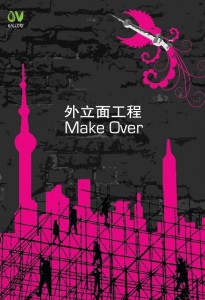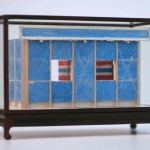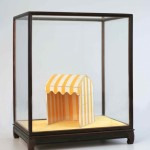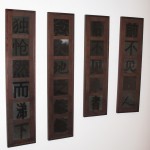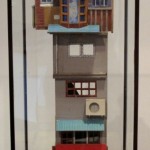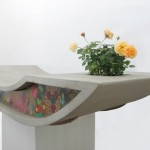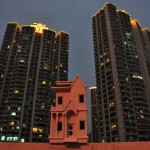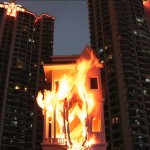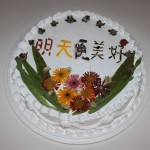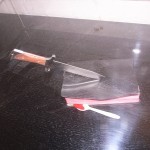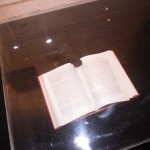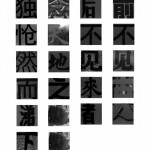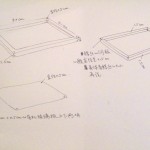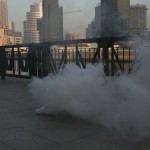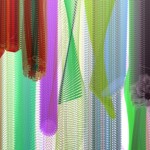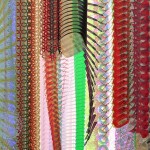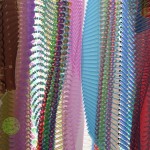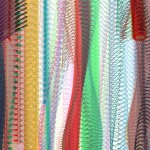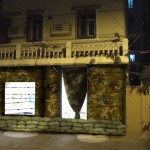Bird Head: Tang Dynasty Poem, photographs on acid-free paper, dimensions variable, 2009-2010
In this project we shot photos of stores signs. We shot each character separately from different signs, only one Chinese character per negative. These black and white negatives are framed and rearranged into a classical Chinese Poem. The Tang Dynasty poem is “On Mounting Youzhou Terrace,” by Chen Zi'ang Where, before me, are the ages that have gone? And where, behind me, are the coming generations? I think of heaven and earth, without limit, without end, and I am all alone and my tears fall down.
Chen Hangfeng: Bubble City Bubble Life, installation, metal, bubble machine, IV drip, 2 x 2 x 2m, 2009-2010
An IV drip filled with soap is linked up to a bubble-making machine which is encased by a wire cage. When the bubble machine is turned on, it releases swarms of bubbles which collide with the wire mesh of the cage and either stick to it or and burst. Only a few of the very lucky ones will manage to escape through holes in the cage. “Bubble City Bubble Life” deals with reality, dreams and hopes. The bubble is a metaphor for a beautiful utopia (which will never be realized) and it conjures up the utopian ideals of the Expo. The IV drip is a metaphor for the human energy and resources which are being pumped into Shanghai to provide life support for this dream. The wire cage references the social structures we live in; we can see through them but we can not really change them. Only few of the bubbles are brave enough to "break" the system and release themselves. But obviously the holes in the cage are not created by the bubbles, nor does the cage suffer any damage from their escape.
Christina Shmigel: The View in Fragments, mixed media installation, paper, vitrines, cardboard, dimensions variable, 2009-2010
Preserved in glass vitrines, are small models inspired by the Shanghai architecture that no one stops to admire: white tiled buildings with blue glass windows, kiosks selling auspicious phone numbers, pre-fab buildings for migrant workers, temporary striped polyethylene tarp structures, teetering rooftop pigeon coops...what is most uncelebrated is presented to the viewer as if it were precious. Re-entering the city from the exhibition, that same viewer will perhaps notice those structures for the first time, “made over” by the imagination.
Gao Mingyan: Constraint, mixed media installation, dimensions variable, 2009-2010
With the rapid development of society, the city is flourishing. It seems human civilization has managed to make improvements to the facades of buildings and people’s appearances. However, do we really make any progress ourselves? Do we really do need to go through this experience?No matter how gorgeous everything looks, our hearts are still imprisoned. This seemingly harmonious society is restricting us. So I’ve packaged the gallery in a military wrapping. This seems a kind of protection, yet in fact it’s a metaphor for the constraint and imprisonment.
Jin Feng: Believe it or Not, installation, 334 x 240, 2009-2010
“Believe it or Not,” is a wall carved with 100 fake news items. We live in an information age and sometimes we confuse truth with falsehoods. It’s difficult for us to differentiate between sharp and dull. We often prefer to regard fake news as real and have it enter into our lives. Every day we are all consumers of this kind of information. We laugh at those who have been deceived, but what if “the cheated” are also an illusion? Who is laughing then? No one knows.
Private: Jutta Friedrichs: Paved Landscapes, installation, resin, wood, household goods, cement, 150 x 60 x 30cm, 2009-2010
The “City image” police go by. “Pack-up and flee!” Suitcases and toy boxes bang closed and scatter; the curtain of the Punch and Judy show falls. Like timid fawns, they are watching from the distance waiting for the air to clear and to return. After Chinese New Year they won’t flee nor come back. The city will be clean and grey.
“We are not thieves; we don’t steel and do no harm, yet we do get punished!“ Caught and trapped, Shanghai’s colorful landscape of vivid vendors rocks restless inside a uniform, ridgid, grey shell of concrete; out of it grows a beautiful blooming flower, conveying a short life-span and constant need for maintenance versus a self-sustained organic streetscape. The tourists will see what they have seen before; the city habitants will have to find new sources for their household goods, the vendors will have to find new jobs in their hometowns. The “City Image” police have done their job.
Private: Maya Kramer: The View from Yesterday, installation, 75 x 165cm, 2009-2010
Shanghai’s explosive development during this past decade is palpable, and the city’s expansion is reminiscent of New York City’s development at the turn of the last century. New York City too once held World’s Fairs, in 1939 and 1964, at Flushing Meadow’s Park in Queens. The park, now desolate with its signature metal globe - the Unisphere, feels haunted by lost 19th century dreams of progress, technical advancement and the unity of man. As Shanghai reframes and represents these older Modernist ideas, I want to re-contextualize this rhetoric. History is cyclical - contrary to 19th century enlightenment ideals everything goes through periods of growth and decline. This event is one chapter in Shanghai’s history, which will pass like others before it.
Qiu Anxiong: Smoke, installation, smoke bomb, dimensions variable, 2009-2010
The smoke bomb (unlike fire crackers) expresses not an idea of celebration and happiness but of caution. It warns that danger is on its way and can also represent a dangerous situation in progress. Smoke obscures our view and creates a sense of disorientation. The Expo projects are now under-way, but they occur out of public view. Nobody knows what is happening behind the construction barricades; they can only see the posters and the slogans outside. These walls are just like walls of smoke. The act of setting off a smoke bomb is the same; after the smoke clears, everything will be visible.
Su Chang: Shelf Life, installation, cream cake, dimensions variable, 2009-2010
This work begins with a cake with the words “Tomorrow Will Be Better” written on it. Using time-lapse photography, I captured the changes to the cake over time. The different ingredients in the cake and different toppings degrade at different rates and asks questions about the transformation of the city and the timelessness of these renovations.
